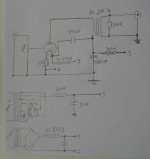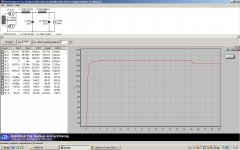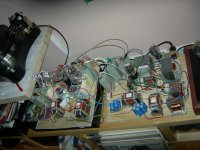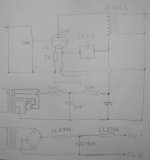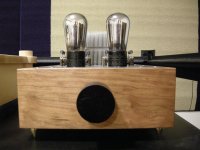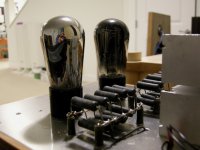10V bias + 1.5V heater + 4V Rod Coleman regulator overhead : 15.5Vanyone tried BATTERY filament bias ?
15.5-16V battery pack, 1A current, 16VA power.
5 hour operation 80VAh ..... need 120-150VAh battery pack.
Recharing time aprox. 10h.
Wasting power, wasting money.
Hi all,
First of all, thank's to everyone who has contributed to this long thread. I think I have read through it all, and it has been very, very helpful for me to get along with my #26 preamp.
I have the amp breadboarded now, and I feel that besides from the PSU and the AVC, there are just small modifications to be made. I run the tube at 120V@8mA. Probably a little bit hot, but I will adjust it down to 5-6mA later on as Kevin suggests. I have tried out both battery grid bias, bypassed cathode, and filament bias. Filament bias is staying, I like it a lot. The sound now is amazing and highly musical with no audible hum in my 98dB speakers.
But what I really need some help with is the PSU. As I don't have acess to a scope, I can't make any measurements. I have have simmed it in PSUD II, but I really don't know what to look for to make i optimal besides ripple.
I attach the PSUD file, a screenshot, schematic and a photo of the nest. If you want to use the PSUD file, remove .doc and rename it.psu
I would like a passive PSU for this amp, preferrably with choke input.
I have one more pair of 20H chokes if that should be needed.
Theo
First of all, thank's to everyone who has contributed to this long thread. I think I have read through it all, and it has been very, very helpful for me to get along with my #26 preamp.
I have the amp breadboarded now, and I feel that besides from the PSU and the AVC, there are just small modifications to be made. I run the tube at 120V@8mA. Probably a little bit hot, but I will adjust it down to 5-6mA later on as Kevin suggests. I have tried out both battery grid bias, bypassed cathode, and filament bias. Filament bias is staying, I like it a lot. The sound now is amazing and highly musical with no audible hum in my 98dB speakers.
But what I really need some help with is the PSU. As I don't have acess to a scope, I can't make any measurements. I have have simmed it in PSUD II, but I really don't know what to look for to make i optimal besides ripple.
I attach the PSUD file, a screenshot, schematic and a photo of the nest. If you want to use the PSUD file, remove .doc and rename it.psu
I would like a passive PSU for this amp, preferrably with choke input.
I have one more pair of 20H chokes if that should be needed.
Theo
Attachments
Last edited:
Hi Theo,
congrats to your 26 preamp! Why do you feel you need to change the PSU? Do you have any hum left?
PSUD2 is a great tool, but it will tell you little about how a PSU impacts the sound. It's a great tool to get your voltages and ripple numbers.
What would be worth trying in your PSU is swap the 8uF and 100uF caps. Put the 100uF after the first choke and the 8uF after the second choke. The last cap is in the signal path and you want the highest quality cap there. It might be worthwhile to increase the 8uF to 20uF, but try the 8uF alone first.
I would not terminate the secondary of your line transformer with 600 Ohms. Try it unterminated or with hoigher resistance values like 10k. 600 Ohm loads the preamp unnecessarily.
Best regards
Thomas
congrats to your 26 preamp! Why do you feel you need to change the PSU? Do you have any hum left?
PSUD2 is a great tool, but it will tell you little about how a PSU impacts the sound. It's a great tool to get your voltages and ripple numbers.
What would be worth trying in your PSU is swap the 8uF and 100uF caps. Put the 100uF after the first choke and the 8uF after the second choke. The last cap is in the signal path and you want the highest quality cap there. It might be worthwhile to increase the 8uF to 20uF, but try the 8uF alone first.
I would not terminate the secondary of your line transformer with 600 Ohms. Try it unterminated or with hoigher resistance values like 10k. 600 Ohm loads the preamp unnecessarily.
Best regards
Thomas
Last edited:
Hi Theo,
congrats to your 26 preamp! Why do you feel you need to change the PSU? Do you have any hum left?
PSUD2 is a great tool, but it will tell you little about how a PSU impacts the sound. It's a great tool to get your voltages and ripple numbers.
What would be worth trying in your PSU is swap the 8uF and 100uF caps. Put the 100uF after the first choke and the 8uF after the second choke. The last cap is in the signal path and you want the highest quality cap there. It might be worthwhile to increase the 8uF to 20uF, but try the 8uF alone first.
I would not terminate the secondary of your line transformer with 600 Ohms. Try it unterminated or with hoigher resistance values like 10k. 600 Ohm loads the preamp unnecessarily.
Best regards
Thomas
Hi Thomas,
Thank's for the advice. There is no hum left, and it sounds very good. Last cap is Black Gate WKZ. I also tried solen polyprop not so good. So I suppose I just need some experienced builders to tell me it looks good or bad. What do you think about adding another LC stage and removing the last cap, leaving the 30H before the ultrapath and OT?
Regarding the termination of the OT. I was under the imperession it is like loading a MC step up. So when I load it with 600R the tube sees 20K load. Have I misunderstood?
Theo
Last edited:
Hi Theo,
I just saw that you have that other 14uF cap in ultrapath connection there. In fact with filament bias, there is not much difference between that and the 8uF since the cathode resistor is low in value. I would leave just a single cap there. You can experiment what sounds better to have it connected to filament or ground. If you have hum, add another LC stage. If you don't have hum, I see no need for that.
Best regards
Thomas
I just saw that you have that other 14uF cap in ultrapath connection there. In fact with filament bias, there is not much difference between that and the 8uF since the cathode resistor is low in value. I would leave just a single cap there. You can experiment what sounds better to have it connected to filament or ground. If you have hum, add another LC stage. If you don't have hum, I see no need for that.
Best regards
Thomas
A scope of some sort...
Congraats on the progress
Anyone working on this stuff really does need a basic scope or something equivalent.
The simplest is to use a buffered op-amp with gain switching to go with a standard 10x cheepie probe, into the line input on the computer. 2 off is even better of course.
You may only get 22kHz (more with modern computers) but that is enough for 99% of analogue audio and power supply work.
There are programs out these that will do a basic display to look at signals or do FFTs even. Free or nominal fee.
e.g. Zelscope: Sound card oscilloscope and spectrum analyzer
Or look out for an Android or iPhone app for a smart phone if there is a mic or line in option.
Best wishes,
Susan.
Congraats on the progress
Hi all,
...
But what I really need some help with is the PSU. As I don't have acess to a scope, I can't make any measurements. I have have simmed it in PSUD II, but I really don't know what to look for to make i optimal besides ripple.
Theo
Anyone working on this stuff really does need a basic scope or something equivalent.
The simplest is to use a buffered op-amp with gain switching to go with a standard 10x cheepie probe, into the line input on the computer. 2 off is even better of course.
You may only get 22kHz (more with modern computers) but that is enough for 99% of analogue audio and power supply work.
There are programs out these that will do a basic display to look at signals or do FFTs even. Free or nominal fee.
e.g. Zelscope: Sound card oscilloscope and spectrum analyzer
Or look out for an Android or iPhone app for a smart phone if there is a mic or line in option.
Best wishes,
Susan.
Simple tube oscilloscope
....
And if one really want to keep with the tube idiom then something like this could be a nice side project.
Parcgwyn DIY Electronics Web Site - Simple Oscilloscope
A search of a certain on-line auction site shows good availability of the DG7-6 CRT tube.
I built something like this when I was a teenager!
Best wishes,
Susan.
....
And if one really want to keep with the tube idiom then something like this could be a nice side project.
Parcgwyn DIY Electronics Web Site - Simple Oscilloscope
A search of a certain on-line auction site shows good availability of the DG7-6 CRT tube.
I built something like this when I was a teenager!
Best wishes,
Susan.
Congraats on the progress
Anyone working on this stuff really does need a basic scope or something equivalent.
The simplest is to use a buffered op-amp with gain switching to go with a standard 10x cheepie probe, into the line input on the computer. 2 off is even better of course.
You may only get 22kHz (more with modern computers) but that is enough for 99% of analogue audio and power supply work.
There are programs out these that will do a basic display to look at signals or do FFTs even. Free or nominal fee.
e.g. Zelscope: Sound card oscilloscope and spectrum analyzer
Or look out for an Android or iPhone app for a smart phone if there is a mic or line in option.
Best wishes,
Susan.
Hi Susan,
Thank's a lot for taking the time and effort to answar my post. However, I do not understand much of what you are talking about
Either I rely on my ears or I simply have to get in touch with someone who has a scope.
Theo
Alberti - what are those resistors you have for the filament bias? Did you do some experimenting to find the best sounding ones?
Andy
They're all Vishay from your supplier. I've the 95w one and I like this combination better.
Ah right - I've been using Dale wirewounds. Obviously you like these Vishay - they are wirewound, right?
andy
Yes, they're wirewound 5w. What I did is to paralle 10pcs 100R 5w to make a 10R 50w. It runs a bit hotter than one 95w which was around 75c as I could remember, but the paralle one are varied from 85c to 95c. The temperature is higher, but sounds better to my ears.
Yes, they are the same. they actually are with the name - Dale - stamped on.
Stereo 26 linestage works correctly with 2 Filament transformers. Please remember, the filament of 26 is the cathode! We don't want any coupling between L-channel's cathode and the R-channel.
With 1 transformer, having 2 secondary windings - the amplifier will work - but 2 completely separate transformers is best (lowest coupling of rectifier current-pulses and noise from winding-to-winding).
LM317 is too noisy for 26 linestage - you will even hear residual noise through the speaker!
With 1 transformer, having 2 secondary windings - the amplifier will work - but 2 completely separate transformers is best (lowest coupling of rectifier current-pulses and noise from winding-to-winding).
LM317 is too noisy for 26 linestage - you will even hear residual noise through the speaker!
There is one possibility: At ground potential you can get away with one filament supply (transformer and Coleman). Put both filaments in series, adjust for 3 Volts. Ground the filament between the two filaments, so you have one 26 at 1.5Volts and one 26 at -1.5Volts. Bias the 26 with a battery (9Volt).
I have tried this succesfully, however not exactly cathode-bias, sound is excellent..
Rob
I have tried this succesfully, however not exactly cathode-bias, sound is excellent..
Rob
- Home
- Amplifiers
- Tubes / Valves
- #26 pre amp
